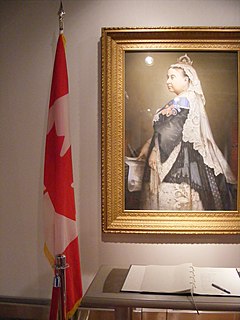Victoria Day
| Victoria Day Fête de la Reine |
|
|---|---|

|
|
| Official name |
Victoria Day French: Fête de la Reine |
| Also called | May Long Weekend, May Long, May Two-Four, May Run |
| Observed by | Canadians |
| Type | Historical, cultural, nationalist |
| Celebrations | Fireworks, parades |
| Date | Last Monday preceding May 25 |
| 2016 date | May 23, 2016 |
| 2017 date | May 22, 2017 |
| 2018 date | May 21, 2018 |
| 2019 date | May 20, 2019 |
| Frequency | annual |
| Related to | Birthday of Queen Victoria |
Victoria Day (French: Fête de la Reine) is a federal Canadian public holiday celebrated on the last Monday preceding May 25, in honour of Queen Victoria's birthday. As such, it is the Monday between the 18th to the 24th inclusive, and thus is always the penultimate Monday of May. The date is simultaneously that on which the current Canadian sovereign's official birthday is recognized. It is sometimes informally considered the beginning of the summer season in Canada.
The holiday has been observed in Canada since at least 1845, originally falling on Victoria's actual birthday. It continues to be celebrated in various fashions across the country; the holiday has always been a distinctly Canadian observance. Victoria Day is a federal statutory holiday, as well as a holiday in six of Canada's ten provinces and all three of its territories. In Quebec, before 2003, the Monday preceding 25 May of each year was unofficially the Fête de Dollard, a commemoration initiated in the 1920s to coincide with Victoria Day. In 2003, provincial legislation officially created National Patriots' Day on the same date.
The birthday of Queen Victoria was a day for celebration in Canada long before Confederation, with the first legislation regarding the event being in 1845 passed by the parliament of the Province of Canada to officially recognize May 24 as the Queen's birthday. It was noted that on that date in 1854, the 35th birthday of Queen Victoria, some 5,000 residents of Canada West gathered in front of Government House (near present-day King and Simcoe Streets in Toronto) to "give cheers to their queen." An example of a typical 19th century celebration of the Queen's birthday took place on May 24, 1866, in Omemee, also in Canada West: the town mounted a day-long fête to mark the occasion, including a gun salute at midnight, pre-dawn serenades, picnics, athletic competitions, a display of illuminations, and a torch-light procession; such events were common around the colony and, by the 1890s, the day had become a "patriotic holiday".
...
Wikipedia
